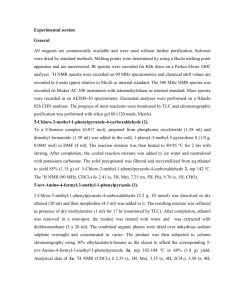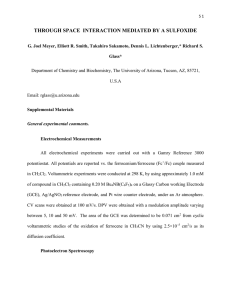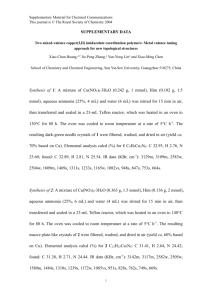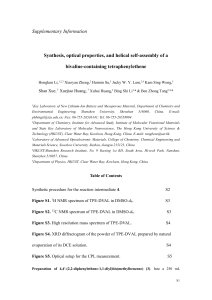Document 13309492
advertisement
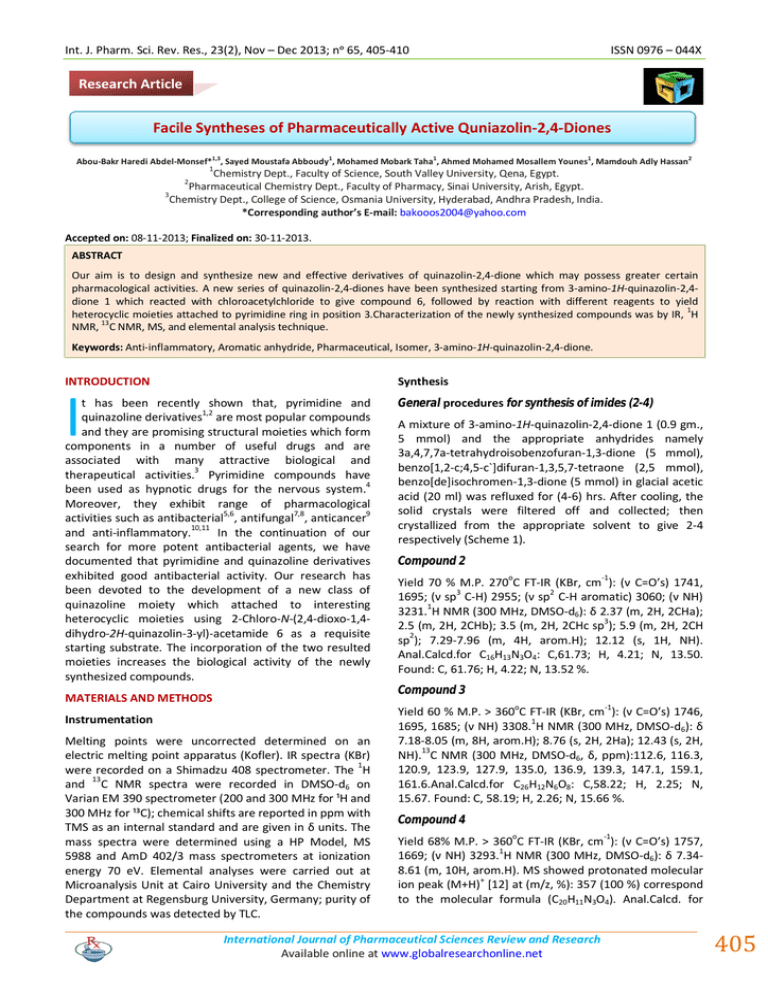
Int. J. Pharm. Sci. Rev. Res., 23(2), Nov – Dec 2013; nᵒ 65, 405-410 ISSN 0976 – 044X Research Article Facile Syntheses of Pharmaceutically Active Quniazolin-2,4-Diones Abou-Bakr Haredi Abdel-Monsef*1,3, Sayed Moustafa Abboudy1, Mohamed Mobark Taha1, Ahmed Mohamed Mosallem Younes1, Mamdouh Adly Hassan2 1 Chemistry Dept., Faculty of Science, South Valley University, Qena, Egypt. Pharmaceutical Chemistry Dept., Faculty of Pharmacy, Sinai University, Arish, Egypt. 3 Chemistry Dept., College of Science, Osmania University, Hyderabad, Andhra Pradesh, India. *Corresponding author’s E-mail: bakooos2004@yahoo.com 2 Accepted on: 08-11-2013; Finalized on: 30-11-2013. ABSTRACT Our aim is to design and synthesize new and effective derivatives of quinazolin-2,4-dione which may possess greater certain pharmacological activities. A new series of quinazolin-2,4-diones have been synthesized starting from 3-amino-1H-quinazolin-2,4dione 1 which reacted with chloroacetylchloride to give compound 6, followed by reaction with different reagents to yield 1 heterocyclic moieties attached to pyrimidine ring in position 3.Characterization of the newly synthesized compounds was by IR, H 13 NMR, C NMR, MS, and elemental analysis technique. Keywords: Anti-inflammatory, Aromatic anhydride, Pharmaceutical, Isomer, 3-amino-1H-quinazolin-2,4-dione. INTRODUCTION Synthesis I t has been recently shown that, pyrimidine and quinazoline derivatives1,2 are most popular compounds and they are promising structural moieties which form components in a number of useful drugs and are associated with many attractive biological and therapeutical activities.3 Pyrimidine compounds have been used as hypnotic drugs for the nervous system.4 Moreover, they exhibit range of pharmacological activities such as antibacterial5,6, antifungal7,8, anticancer9 and anti-inflammatory.10,11 In the continuation of our search for more potent antibacterial agents, we have documented that pyrimidine and quinazoline derivatives exhibited good antibacterial activity. Our research has been devoted to the development of a new class of quinazoline moiety which attached to interesting heterocyclic moieties using 2-Chloro-N-(2,4-dioxo-1,4dihydro-2H-quinazolin-3-yl)-acetamide 6 as a requisite starting substrate. The incorporation of the two resulted moieties increases the biological activity of the newly synthesized compounds. General procedures for synthesis of imides (2-4) A mixture of 3-amino-1H-quinazolin-2,4-dione 1 (0.9 gm., 5 mmol) and the appropriate anhydrides namely 3a,4,7,7a-tetrahydroisobenzofuran-1,3-dione (5 mmol), benzo[1,2-c;4,5-c`]difuran-1,3,5,7-tetraone (2,5 mmol), benzo[de]isochromen-1,3-dione (5 mmol) in glacial acetic acid (20 ml) was refluxed for (4-6) hrs. After cooling, the solid crystals were filtered off and collected; then crystallized from the appropriate solvent to give 2-4 respectively (Scheme 1). Compound 2 Yield 70 % M.P. 270oC FT-IR (KBr, cm-1): (ν C=O’s) 1741, 1695; (ν sp3 C-H) 2955; (ν sp2 C-H aromatic) 3060; (ν NH) 3231.1H NMR (300 MHz, DMSO-d6): δ 2.37 (m, 2H, 2CHa); 3 2.5 (m, 2H, 2CHb); 3.5 (m, 2H, 2CHc sp ); 5.9 (m, 2H, 2CH 2 sp ); 7.29-7.96 (m, 4H, arom.H); 12.12 (s, 1H, NH). Anal.Calcd.for C16H13N3O4: C,61.73; H, 4.21; N, 13.50. Found: C, 61.76; H, 4.22; N, 13.52 %. Compound 3 MATERIALS AND METHODS Instrumentation Melting points were uncorrected determined on an electric melting point apparatus (Kofler). IR spectra (KBr) were recorded on a Shimadzu 408 spectrometer. The 1H and 13C NMR spectra were recorded in DMSO-d6 on Varian EM 390 spectrometer (200 and 300 MHz for ¹H and 300 MHz for ¹³C); chemical shifts are reported in ppm with TMS as an internal standard and are given in δ units. The mass spectra were determined using a HP Model, MS 5988 and AmD 402/3 mass spectrometers at ionization energy 70 eV. Elemental analyses were carried out at Microanalysis Unit at Cairo University and the Chemistry Department at Regensburg University, Germany; purity of the compounds was detected by TLC. Yield 60 % M.P. > 360oC FT-IR (KBr, cm-1): (ν C=O’s) 1746, 1695, 1685; (ν NH) 3308.1H NMR (300 MHz, DMSO-d6): δ 7.18-8.05 (m, 8H, arom.H); 8.76 (s, 2H, 2Ha); 12.43 (s, 2H, NH).13C NMR (300 MHz, DMSO‐d6, δ, ppm):112.6, 116.3, 120.9, 123.9, 127.9, 135.0, 136.9, 139.3, 147.1, 159.1, 161.6.Anal.Calcd.for C26H12N6O8: C,58.22; H, 2.25; N, 15.67. Found: C, 58.19; H, 2.26; N, 15.66 %. Compound 4 Yield 68% M.P. > 360oC FT-IR (KBr, cm-1): (ν C=O’s) 1757, 1669; (ν NH) 3293.1H NMR (300 MHz, DMSO-d6): δ 7.348.61 (m, 10H, arom.H). MS showed protonated molecular + ion peak (M+H) [12] at (m/z, %): 357 (100 %) correspond to the molecular formula (C20H11N3O4). Anal.Calcd. for International Journal of Pharmaceutical Sciences Review and Research Available online at www.globalresearchonline.net 405 Int. J. Pharm. Sci. Rev. Res., 23(2), Nov – Dec 2013; nᵒ 65, 405-410 C20H11N3O4: C, 67.23; H, 3.10; N, 11.76. Found: C, 67.25; H, 3.11; N, 11.74 %. 1H,3H-quinazolin-2,4-dione (5) A cooled solution of NaNO2 (0.7 gm.) in water (10 ml) was added drop by drop during 30 minutes to a cooled solution of compound 1 (1.7gm., 10 mmol) in HCl (30 ml) with stirring at 0oC. Stirring continues for 2 hrs., the precipitate formed was isolated by filtration, washed with water; then crystallized from commercial ethanol to give 1H,3H-quinazolin-2,4-dione 5 (1.33 gm., 8 mmol) as white needles (Scheme 2). Yield 85 % M.P. 320oC FT-IR (KBr, cm-1): (ν C=O’s) 1705, 1675; (ν NH) 3247. MS showed + protonated molecular ion peak (M+H) at (m/z, %): 162 (100 %) correspond to the molecular formula (C8H6N2O2). Anal.Calcd.for C8H6N2O2: C, 59.26; H, 3.73; N, 17.28. Found: C, 59.23; H, 3.74; N, 17.29 %. 2-chloro-N-(2,4-dioxo-1,4-dihydro-2H-quinazolin-3-yl)acetamide (6) Treatment of a solution of 3-amino-1H-quinazolin-2,4dione 1 (0.53 gm., 3 mmol) in 10 ml DMF with chloro acetylchloride (0.16 ml) drop wisely during stirring at room temperature. The reaction mixture was further stirred for 2 hrs., then diluted with cold water. The solid formed was filtered off; then crystallized from benzene to give 2-Chloro-N-(2,4-dioxo-1,4-dihydro-2H-quinazolin-3yl) acetamide 6 in yield 85% as white crystals (Scheme 3). M.P. 216 oC FT-IR (KBr, cm-1): (νC=O’s) 1740, 1670; (νNH) 3200. 1H NMR (300 MHz, DMSO-d6): δ 4.33 (s, 2H, CH2); 7.22-7.96 (m, 4H, arom.H); 10.94 (s, 1H, NH); 11.68 (s, 1H, NH). MS showed molecular ion peak at (m/z=253, 28.83%) for 35Cl and at (m/z=255, 10.23%) for 37Cl correspond to the molecular formula (C10H8N3O3Cl). Anal.Calcd.for C10H8N3O3Cl: C, 47.35; H, 3.18; N, 16.57; Cl, 13.98. Found: C, 47.55; H, 3.15; N, 16.52; Cl, 13.94 %. General procedures for synthesis of N-(2,4-dioxo-1,4dihydro-2H-quinazolin-3-yl)-2-piperidin-1-yl-acetamide (7a)and N-(2,4-dioxo-1,4-dihydro-2H-quinazolin-3-yl)-2morpholin-4-yl-acetamide (7b) 2-Chloro-N-(2,4-dioxo-1,4-dihydro-2H-quinazolin-3-yl) acetamide 6 (0.5 gm., 2 mmol) was added to a solution of piperidine and/ or morpholine (2 mmol) in absolute ethanol (30 ml) in presence of K2CO3 (0.42 gm., 3 mmol). The reaction mixture was stirred for 6 hrs., the solid formed was filtered off, washed with water; then crystallized from toluene to afford N-(2,4-dioxo-1,4dihydro-2H-quinazolin-3-yl)-2-piperidin-1-yl-acetamide 7a in yield 55% as white crystals and N-(2,4-dioxo-1,4dihydro-2H-quinazolin-3-yl)-2-morpholin-4-yl-acetamide 7b in yield 45% as yellow crystals (Scheme 3). Compound (7a) M.P. 224oC FT-IR (KBr, cm-1): (νC=O’s) 1741, 1695; (νNH) 1 3231. H NMR (300 MHz, DMSO-d6): δ 1.41 (m, 2H, CH2); 1.57 (m, 4H, 2CH2); 2.5 (t, 4H, 2CH2); 3.1 (s, 2H, CH2); 7.27.95 (m, 4H, arom.H); 10.2 (s, 1H, NH); 11.7 (s, 1H, NH). + MS showed protonated molecular ion peak (M+H) at ISSN 0976 – 044X (m/z, %): 303 (5.00 %) correspond to the molecular formula (C15H19N4O3). Anal.Calcd.for C15H18N4O3: C, 59.59; H, 6.0; N, 18.53. Found: C, 60.05; H, 5.98; N, 18.51 %. Compound (7b) o -1 M.P. 236 C FT-IR (KBr, cm ): (νC=O’s) 1746, 1695, 1685; (νNH) 3308. 1H NMR (300 MHz, DMSO-d6): δ 2.57 (t, 2H, 2CH2-N); 3.17 (s, 2H, CH2); 3.65 (t, 4H, 2CH2-O); 7.22-7.95 (m, 4H, arom.H); 10.3 (s, 1H, NH); 11.6 (s, 1H, NH). Anal.Calcd.for C14H16N4O4: C, 55.26; H, 5.30; N, 18.41. Found: C, 55.23; H, 5.31; N, 18.39 %. 1,4-bis[(2,4-dioxo-1,4-dihydro-2H-quinazolin-3-ylcarbamoyl)-methyl]-piperazine (8) Compound 6 (0.5 gm., 2 mmol) was added to a solution of piperazine (1 mmol) in absolute ethanol (30 ml) in presence of K2CO3 (0.42 gm., 3 mmol). The reaction mixture was stirred for 6 hrs., the solid formed was filtered off, washed with water; then crystallized from DMF to afford 1,4-bis[(2,4-dioxo-1,4-dihydro-2Hquinazolin-3-yl-carbamoyl)-methyl]piperazine 8 in yield 48% as white crystals (Scheme 3). M.P. > 360oC FT-IR (KBr, cm-1): (νC=O’s) 1757, 1669; (νNH) 3293.1H NMR (300 MHz, DMSO-d6): δ 2.68 (s, 8H, 4CH2); 3.35 (s, 4H, 2CH2); 7.227.96 (m, 8H, arom.H); 10.27 (broad s, 2H, 2NH); 11.6 (broad s, 2H, 2 NH). MS showed protonated molecular ion peak (M+H)+at (m/z, %): 521 (100 %) correspond to the molecular formula (C24H25N8O6). Anal.Calcd.for C24H24N8O6: C, 55.38; H, 4.65; N, 21.53. Found: C, 55.43; H, 4.63; N, 21.52 %. 3-(2,5-dioxo-imidazolidin-1-yl)-1H-quinazolin-2,4-dione (9a) A mixture of 2-chloro-N-(2,4-dioxo-1,4-dihydro-2Hquinazolin-3-yl)-acetamide 6 (1 gm., 4 mmol) and urea (4 mmol) in ethanol (20 ml) in presence of anhydrous K2CO3 (0.7 gm., 5 mmol), was refluxed until ammonia odour has stopped (10 hrs.). The solid formed was filtered off, washed with water, then crystallized from 1,4-dioxane to afford 3-(2,5-dioxo-imidazolidin-1-yl)-1H-quinazolin-2,4dione 9a in yield 62 % as white crystals (Scheme 4).M.P. > 360 oC. FT-IR (KBr, cm-1): (ν C=O’s) 1760, 1690; (ν NH) 1 3320, 3290. H NMR (200 MHz, DMSO-d6): δ 4.54 (s, 2H, CH2); 7.26-8.0 (m, 4H, arom.H). MS (m/z, %): 260 (29.20%) correspond to the molecular formula (C11H8N4O4). Anal.Calcd.for C11H8N4O4: C, 50.78; H, 3.10; N, 21.53. Found: C, 50.84; H, 3.08; N, 21.51 %. 3-(2-thioxo-2,5-dihydro-1H-imidazol-4-ylamino)-1Hquinazolin-2,4-dione (9b) When 2-chloro-N-(2,4-dioxo-1,4-dihydro-2H-quinazolin-3yl) acetamide 6 (1 gm., 4 mmol) and thiourea (4 mmol) in ethanol (20 ml) in presence of anhydrous K2CO3 (0.7 gm., 5 mmol), were heated under reflux for 12 hrs. After cooling the reaction mixture was neutralized with concentrated HCl. The precipitated solid was filtered off, crystallized from ethanol to give 3-(2-thioxo-2,5-dihydro1H-imidazol-4-yl-amino)-1H-quinazolin-2,4-dione 9b in yield 55 % as deep yellow crystals (Scheme 4). M.P. > 360 International Journal of Pharmaceutical Sciences Review and Research Available online at www.globalresearchonline.net 406 Int. J. Pharm. Sci. Rev. Res., 23(2), Nov – Dec 2013; nᵒ 65, 405-410 o -1 C. FT-IR (KBr, cm ):(ν C=O’s) 1710, 1650; (ν NH’s) 3290, 3200. 1H NMR (200 MHz, DMSO-d6): δ 3.6 (s, 2H, CH2); 7.19-7.97 (m, 5H, arom.H+NH); 10.72 (s, 1H, NH); 11.7 (s, 1H, NH). MS (m/z, %): 275 (1.44 %) correspond to the molecular formula (C11H9N5O2S). Anal.Calcd.for C11H9N5O2S: C, 47.99; H, 3.30; N, 25.44; S, 11.65. Found: C, 48.04; H, 3.31; N, 25.42; S, 11.63 %. 2-(Benzothiazol-2-yl-sulfanylmethyl)(1,3,4)-oxadiazolo [2,3-b]-4H,5H-quinazolin-5-one (10) An equimolar amounts of compound 6 (0.5 gm., 2 mmol) and 2-mercaptobenzothiazole (0.5gm., 3mmol) in acetone (30 ml) in presence of dry K2CO3 (0.55 gm., 4 mmol), was heated under reflux for 5 hrs. After cooling, the solid formed was filtered off, washed with water, then crystallized from ethanol to give 2-(Benzothiazol-2-ylsulfanyl-methyl)(1,3,4)oxadiazolo[2,3-b](4H,5H) quinazolin-5-one 10 in yield 90% as yellow crystals o -1 (Scheme 4). M.P. 260 C FT-IR (KBr, cm ): (ν C=O) 1695; and the absence of any band due to NH vibration. 1H NMR (200 MHz, DMSO-d6): δ 4.25 (s, 2H, CH2); 6.88-8.03 (m, 8H, arom.H). MS (m/z, %): 366 (27.60%) correspond to the molecular formula (C17H10N4O2S2). Anal.Calcd.for C17H10N4O2S2: C, 55.73; H, 2.75; N, 15.29; S, 8.73. Found: C, 55.76; H, 2.74; N, 15.30; S, 8.71 %. 3-(4-oxo-3H,4H,5H-thiazolidin-2-ylideneamino)-1Hquinazolin-2,4-dione (E-isomer) (11a) and (Z-isomer) (11b) A mixture of 2-chloro-N-(2,4-dioxo-1,4-dihydro-2Hquinazolin-3-yl)acetamide 6 (0.5 gm., 2 mmol) and ammonium thiocyanate (0.23 gm., 3 mmol) in ethanol (30 ml) is heated under reflux for 2 hrs. The solid was formed during the reaction was filtered off, crystallized from acetic acid to afford the isomeric mixture of 3-(4-oxo3H,4H,5H-thiazolidin-(2E)-ylideneamino)-1H-quinazolin2,4-dione 11a and 3-(4-oxo-3H,4H,5H-thiazolidin-(2Z)ylideneamino)-1H-quinazolin-2,4-dione 11b in yield 70% as white crystals(Scheme 4). M.P. > 360 oC. FT-IR (KBr, cm1 ): (ν C=O’s) 1735, 1695, 1660; (ν NH) 3230-3200. 1H NMR (200 MHz, DMSO-d6): confirmed the proposed structures of 11a and 11b and it indicates different signals for the two isomers at δ 4.12 (s, 2H, CH2) for 11a; 4.21 (s, 2H, CH2) for 11b; 7.26-8.02 (m, 4H, arom.H) for both isomers; 11.72 (s, 1H, NH) for 11a; 11.71 (s, 1H, NH) for 11b; 12.48 (s, 1H, NH) for 11a and 12.28 (s, 1H, NH) for 11b. Anal.Calcd.for C11H8N4O3S: C, 47.82; H, 2.92; N, 20.28; S, 11.61. Found: C, 47.77; H, 2.94; N, 20.29; S, 11.60 %. 3-(2-imino-4-oxo-3H,4H,5H-thiazolidin-3-yl)-1Hquinazolin-2,4-dione (12) A mixture of 2-chloro-N-(2,4-dioxo-1,4-dihydro-2Hquinazolin-3-yl)acetamide 6 (0.5 gm., 2 mmol) and potassium thiocyanate (0.29 gm., 3 mmol) in acetone (30 ml) is heated under reflux for 2 hrs. The solid formed during the reaction was filtered off, crystallized from ethanol to afford 3-(2-imino-4-oxo-3H,4H,5H-thiazolidin3-yl)-1H-quinazolin-2,4-dione 12 in yield 75% as white o -1 crystals (Scheme 4).M.P. 280 C FT-IR (KBr, cm ): (ν C=O’s) ISSN 0976 – 044X 1 1715, 1685; (ν NH) 3290. H NMR (200 MHz, DMSO-d6): δ 4.32 (s, 2H, CH2); 7.27-7.98 (m, 4H, arom.H); 9.59 (s, 1H, NH); 11.59 (s, 1H, NH). MS (m/z, %): 276 (29.30 %) correspond to the molecular formula (C11H8N4O3S). Anal.Calcd.for C11H8N4O3S: C, 47.82; H, 2.92; N, 20.28; S, 11.61. Found: C, 47.84; H, 2.93; N, 20.27; S, 11.60 %. RESULTS AND DISCUSSION Owing to the importance of quinazoline derivatives which documented in our previous studies13-17, here we have developed the synthesis of some new interesting derivatives of quinazolin-2,4-dione which may use as potential pharmaceuticals. Synthetic scheme 1 illustrates the effect of different aromatic anhydrides on compound 1 in different ratios like (1:1) and (2:1). Treatment of 3amino-1H-quinazolin-2,4-dione 1 with different aromatic anhydride namely 3a,4,7,7a-tetrahydroisobenzofuran-1,3dione, benzo[1,2-c;4,5-c`]difuran-1,3,5,7-tetraoneand benzo[de]isochromen-1,3-dione in acetic acid under reflux gave the corresponding imides 2, 3 and 4 respectively. Scheme 2 shows the effect of nitrous acid on compound 1. Diazotization of compound 1 followed by addition of malononitrile or diethyl malonate to introduce diazo group in position-3 was unsuccessful. The only formed product was identified as 1H,3H-quinazolin-2,4dione. Scheme3 illustrates the way used to synthesize the requisite starting material 2-chloro-N-(2,4-dioxo-1,4dihydro-2H-quinazolin-3-yl) acetamide 6 which was used in the synthesis of several quinazolin-2,4-one derivatives. Treatment of 3-amino-1H-quinazolin-2,4-dione 1 with chloroacetyl chloride drop by drop with stirring in DMF followed by addition of H2O gave 2-chloro-N-(2,4-dioxo1,4-dihydro-2H-quinazolin-3-yl)acetamide 6 in an excellent yield. When compound 6 is stirred with piperidine, morpholine and/or piperazine in ethanol in presence of anhydrous K2CO3, it gave the corresponding imides N-(2,4-dioxo-1,4-dihydro-2H-quinazolin-3-yl)-2piperidin-1-yl-acetamide 7a, N-(2,4-dioxo-1,4-dihydro-2Hquinazolin-3-yl)-2-morpholin-4-yl-acetamide 7b and 1,4bis[(2,4-dioxo-1,4-dihydro-2H-quinazolin-3-yl-carbamoyl)methyl]piperazine 8 respectively. Furthermore, we investigated of the effect of urea, thiourea and thiocyanates on compound 6 as shown in (Scheme 4). Addition of urea to starting material6under reflux until ammonia odour has ceased, it afforded 3-(2,5-dioxoimidazolidin-1-yl)-1H-quinazolin-2,4-dione 9a. Similarly when compound 6 was added to thiourea, it afforded 3(2-thioxo-2,5-dihydro-1H-imidazol-4-yl-amino)-1Hquinazolin-2,4-dione 9b.The reaction of compound 6 with 2-mercaptobenzothiazole in acetone yielded 2(Benzothiazol-2-yl-sulfanylmethyl) (1,3,4)oxadiazolo[2,3b]-4H,5H-quinazolin-5-one 10 in a good yield. On treatment of compound 6 with ammonium thiocyanate under reflux, it gave two isomeric forms of compound 3(4-oxo-3H,4H,5H-thiazolidin-2-yl-ideneamino)-1Hquinazolin-2,4-dione (E-form) 11a and (Z-form) 11b in a 18 ratio of 2:1 respectively . Attempts to isolate the two isomers using column chromatography and HPLC were unsuccessful. The presence of the two isomers and their International Journal of Pharmaceutical Sciences Review and Research Available online at www.globalresearchonline.net 407 Int. J. Pharm. Sci. Rev. Res., 23(2), Nov – Dec 2013; nᵒ 65, 405-410 1 ratio was indicated from the H-NMR spectra. The integration curves of the signals confirmed the ratio, and it is suggested that the major product is structure 11a due to:- ISSN 0976 – 044X Finally, when compound 6 was allowed to react with potassium thiocyanate under reflux, it gave 3-(2-imino-4oxo-3H, 4H, 5H-thiazolidin-3-yl)-1H-quinazolin-2,4-dione 12. It was expected that the imino group could be hydrolyzed but ammonia odour was not detected during the reaction19. The Formation of Compound 12 may proceed according to the Dimroth type Rearrangement mechanism20 as illustrated in (Scheme 5). In conclusion, the recent study focused primarily on the synthesis of several and effective quinazoline derivatives which may have significant role in drug design. Diverse chemical structures were evaluated by IR, 1H NMR, 13C NMR, MS, and elemental analysis technique. (1) The size of nitrogen atom is smaller than that of sulfur, thus 11a is the more stable because it shows less steric hindrance with carbonyl oxygen atom than 11b. (2) The repulsive force between the atomic orbitals bearing the none bonding electrons is smaller in case of 11a than 11b. Separation of this mixture using various chromatographic methods such as column chromatography, HPLC and preparative TLC was not possible. O H N O N O O O H N O N O O O O O N AcOH reflux O 4 H N O N AcOH reflux NH 2 O O O Hc Ha 1 O (2 moles of 1) AcOH reflux O 2 3 O 7 1 5 O O H N O O N N O 4 6 O N N Hb 2 O O 9 10 11 Hc H a Hb N N 8 H O O O 3 Scheme 1 H N O N C N , N a N O 2/ H C l s tir r in g , 0 -5 H N o C N C N O N H 2 O C O O Et 1 N a N O 2/ H C l , stirrin g , 0 -5 C N O H N N H N C O N N o C O O Et O 5 C H N O N O N N C O O Et C O O Et Scheme 2 International Journal of Pharmaceutical Sciences Review and Research Available online at www.globalresearchonline.net 408 Int. J. Pharm. Sci. Rev. Res., 23(2), Nov – Dec 2013; nᵒ 65, 405-410 H N O N H N ClCH 2 COCl NH 2 O 1 H N X HN O N DMF O ISSN 0976 – 044X O O N Cl N H EtOH/K 2 CO 3 Stirring O O X N N H X= CH 2, O 7a,b 6 NH HN EtOH/K 2 CO 3 Stirring H N O N O O N N N H O H N O N O N H 8 Scheme 3 H N O N H 2 N - C ( X )- N H 2 N S H N O N O X= S N O N N 10 H N N H 4S C N/Etha nol O O HN N re flu x S S N O 6 S N N H 9b SH Cl N H O X= O aceto ne/ K 2 C O 3 r e fl u x O N H H N O N O 9a H N N O E t O H , re flu x O H N + S N O S : 2 H N O N H N O 1 1 a ,b K S C N/A ceto ne O N 1 O O N re flu x N O S HN 12 Scheme 4 O N N H H N O O K S C N O O H O C l N N O N H : H O S N N N 6 S + O N H N - + - H + H + O O S N N O N H N H 1 2 Scheme 5 Acknowledgment: The authors are grateful to the spirit of Prof. Dr. Youssef Hassan Ebeed, Faculty of Science, South Valley University, Egypt. 2. Hassan AM, Seleem AM, Younes MMA, Taha MM, AbdelMonsef HA, Utility of (2,4‐dioxo‐1,4‐dihydro‐ 2H‐quinazolin‐3‐yl)‐acetic acid hydrazidein the synthesis of some heterocyclic nitrogen compounds, Eur. J. Chem., 4(2), 2013, 168-171. 3. Patel R, Desai K, Chikhalia K, Synthesis and evaluation of novel quinolylchalcone as antibacterial agents, J. Ind. Chem. Soc., 80, 2003, 138-145. REFERENCES 1. Hassan AM, Seleem AM, Younes MMA, Taha MM, AbdelMonsefHA, Synthesis and spectral characterization of some heterocyclic nitrogen compounds, Eur. J. Chem, 4(2), 2013, 121-123. International Journal of Pharmaceutical Sciences Review and Research Available online at www.globalresearchonline.net 409 Int. J. Pharm. Sci. Rev. Res., 23(2), Nov – Dec 2013; nᵒ 65, 405-410 ISSN 0976 – 044X 4. Wang SQ, Fang L, Liu XJ, Zhao K, Design, synthesis, and hypnotic activity of pyrazolo[1,5-a] pyrimidine derivatives, Chinese Chem. Lett., 15, 2004, 885-888. 13. Hassan AM, Younes MMA, Taha MM, Abdel-Monsef HA, Synthesis and reactions of 3‐aminotetrachloro quinazolin‐2,4‐dione, Eur. J. Chem., 2(4), 2011, 514-518. 5. Sharma P, Rane N, Gurram VK, Synthesis and QSAR studies of pyrimido[4,5-d]pyrimidine-2,5-dione derivatives as potential antimicrobial agents, Bioorg. Med. Chem. Lett., 14, 2004, 4185-4190. 14. Hassan AM, Younes MMA, Taha MM, Abdel-Monsef HA, Action of Some Heterocyclic Amines and Difunctional Nucleophiles on N-Phenylsulphonyloxy-tetrachloro phthalimide, Chemistry Journal, 2 (5), 2012, 158-165. 6. Elkholy YM, Morsy MA, Facile Synthesis of 5, 6, 7, 8Tetrahydropyrimido[4,5-b]-quinoline Derivatives, Molecules, 11, 2006, 890-903. 7. Holla BS, Mahalinga M, Karthikeyan MS, Akberali PM, Shetty NS, Synthesis of some novel pyrazolo[3,4d]pyrimidine derivatives as potential antimicrobial agents, Bioorg. Med.Chem., 14, 2006, 2040-2047. 15. Hassan AM, Younes MMA, Taha MM, Salem MW, AbdelMonsef HA, An Efficient Synthesis of Biologically Active Tetrachloroquinazolin-2,4-dione, Chem. Sci Journal, 2012, CSJ-87. 8. 9. Ingarsal N, Saravanan G, Amutha P, Nagarajan S, Synthesis, in vitro antibacterial and antifungal evaluations of 2-amino4-(1-naphthyl)-6-arylpyrimidines, Eur. J. Med .Chem., 42, 2007, 517-520. Zhao XL, Zhao YF, Guo SC, Song HS, Wang D, Gong P, Synthesis and anti-tumour activities of novel [1,2,4]triazolo[1,5-a]pyrimidines, Molecules, 12, 2007, 1136-1146. 16. Younes MMA, Taha MM, Abdel-Monsef HA, (2,4-Dioxo-1,4Dihydro-2H-Quinazolin-3-yl)-acetic acid hydrazide: Synthesisand Reactions, J. Asian Sci. Res., 3 (8), 2013, 800809. 17. Hassan AM, Younes MMA, Taha MM, Abboudy MS, AbdelMonsef HA, Applications of 3-Amino-1H-quinazolin-2,4dione in Heterocyclic Chemistry, journal of Applicable Chemistry, 2013 (Accepted). 18. Antintas H, Ates O, Kocabalkanli A, Birteksoz S, Otuk G, Indian J. Chem. Sect. B: Org. Chem. Incl. Med. Chem., 2005, 44, 585-590. 10. Sondhi SM, Singh N, Johar M, Kumar A, Synthesis, antiinflammatory and analgesic activities evaluation of some mono, bi, tricyclic pyrimidine derivatives, Bioorg. Med. Chem., 13, 2005, 6158-6166. 19. Liu HL, Li Z, Anthonsen T, Synthesis and Fungicidal Activity of 2-Imino-3-(4-aryl-thiazol-2-yl)-thiazolidin-4-ones and their 5-Arylidene Derivatives, Molecules, 5, 2000, 10551061. 11. Amin KM, Hanna MM, Abo-Youssef HE, George RF, Synthesis, analgesic and anti-inflammatory activities of some bi-, tri- and tetracyclic condensed pyrimidines, Eur. J. Med. Chem., XXX, 2009, 1-13. 20. Hassan AM, Younes MMA, Taha MM, Abdel-Monsef HA, Synthesis and Reactions of 3-(2-Chloromethylcarbonylamino)-tetrachloroquinazolin-2,4-dione, Org. Chem. Int., 2012, Article ID 284947, 4 pages, doi:10.1155/2012/284947. 12. Pndrew D, Hammoud J, Major H, Eur. J. of Mass Spectrometry, 16, 2, 2010, 169. Source of Support: Nil, Conflict of Interest: None. International Journal of Pharmaceutical Sciences Review and Research Available online at www.globalresearchonline.net 410




